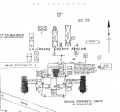La Crosse County Asylum
| La Crosse County Asylum | |
|---|---|
 | |
| Construction Began | 1887 |
| Opened | 1888 |
| Closed | 1975 |
| Demolished | 1976 |
| Current Status | Demolished |
| Building Style | Single Building |
| Location | West Salem, WI |
| Alternate Names |
|
History[edit]
Prior to the establishment of the La Crosse County Insane Asylum in 1888, those suffering mental illness were housed as inmates at the county jail. In 1871, the County board of supervisors moved to have those suffering mental illness to be transferred to a better facility. In 1887, the La Crosse County’s board of trustees allocated money for the establishment of a county insane asylum. With the funds, the county acquired a 210 acre farm 10 miles east of La Crosse (in West Salem, Wisconsin) and construction began on the hospital. In 1888, the facility opened and served 104 patients during its first year. In 1911, as the facility grew and began to house more and more patients, it became necessary to expand the building and major expansions to the 1888 building were made.
Throughout the La Crosse County Insane Asylum/County Hospital’s history, the hospital has owned and operated a farm on the hospital grounds. Patients often had specific jobs and tasks on the farm as part of their stay at the hospital. Much of the produce grown on the farm as well as the meat and dairy products raised on the farm were used for groceries for the hospital patients. The remaining stock was sold for additional hospital funding.
The 1964 Treatment Law, signed by Governor John Reynolds, proposed that the treatment of mentally ill persons in Wisconsin be improved by providing for it at the local level. Up until 1965, the attempt at curing mentally ill patients was only made in state institutions, not at the 35 county hospitals, which includes La Crosse’s. However, at the time the County Hospital was already above capacity and the challenge they faced with this new mental health law was to deal with the increase of patients and be required to hire on more staff at the county hospital, without additional funding. To offset these costs, the hospital doubled its dairy herd in 1965. In 1965, the first psychiatrist was hired on part time to the hospital’s staff. In November 1968, the County Hospital’s name was changed to Lakeview. At this time, two other county institutions had their names changed as well: Hillview Home for the aged became Hillview, and Oak Forest Sanatorium became Oak Forest.
In the early 1970s, as overcrowding at Lakeview continued to get worse, discussion began regarding whether to expand the current hospital facility or to build new. Because the cost to renovate the previous building was too great, it was decided in 1973 to build a new facility near the previous hospital in West Salem. In August 1975, the new six million dollar Lakeview facility opened. The original building was demolished in 1976. In 1987 the Lakeview farm’s cattle herd was sold off and in 1989 the 40 acre farm land was sold to the village of West Salem at $5,000 an acre for the development of an industrial park.
By 1990, La Crosse County looked at closing two of its county facilities to consolidate patients at one nursing home. This proposal suggested closing Lakeview hospital. However, there was much opposition to this proposal as the closing of Lakeview would mean closing the only special needs facility in the county and that part of the state. However, due to the substantial opposition to closing the facility, the movement was tabled in 1992 and never revisited. To accommodate for not closing Lakeview, funding and the number of beds at the facility were cut.
In 2013, the county found the 1975 Lakeview building to not be meeting its needs and passed a plan to build a new center. In October 2016, construction was completed on a new 17 million dollar Lakeview facility to replace the 1975 building. The 2016 facility is located adjacent to the old building, and is on Garland Street (which is across the street from where the 1888 facility stood). The 2016 building has the capacity to house 225 patients. The old 1975 building was purchased and demolished to create residential housing.

